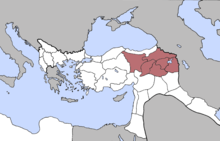TheSix Vilayets(Ottoman Turkish:ولايت سته,Vilâyat-ı Sitte), theSix Provinces,or theSix Armenian Vilayets(Armenian:Վեց Հայկական ՎիլայեթներըVets' haykakan vilayet'nery;Turkish:Altı vilayet, Altı il[1]) were the main Armenian-populatedvilayets( "provinces" ) of theOttoman Empire.These wereVan,Erzurum,Mamuret-ul-Aziz,Bitlis,DiyarbekirandSivas.
Six Vilayets
| |
|---|---|
| Vilayets ofOttoman Empire | |
 The six Armenian provinces in early 20th century. | |
| Today part of | Turkey |
Name
editThe termSix Armenian Vilayetswas a diplomatic usage referring to the Ottoman provinces with substantial Armenian populations. In fact, this term was known in the diplomatic language of the time as the area for which a number of Great Powers wished reforms for the benefit of the Armenians.[2]The term was based on the official language adopted by the signatories of theTreaty of Berlin,the final act of theCongress of Berlinin 1878, in Article LXI: “The Sublime Porte undertakes to carry out, without further delay, the improvements and reforms demanded by local requirements in the provinces inhabited by the Armenians, and to guarantee their security against the Circassians and Kurds.”[3]
Population
editEthnic groups
edit- Statistical analysis of the racial elements in the Ottoman provinces by the Armenian Patriarch of Constantinople, 1912[4]
Note: The analysis excludes certain portions of these provinces where Armenians are only a minor element. These portions are as follows: Hakkiari, in the Vilayet of Van; the south of Sairt, in the Vilayet of Bitlis; the south of the Vilayet of Diyarbekir; the south of Malatia, in the Vilayet of Mamuret-ul-Aziz; the north-west and west of the Vilayet of Sivas.[4]
| Ethnic groups | Bitlis | Diyarbekir | Erzurum | Mamuret-ul-Aziz | Sivas | Van | TOTAL | % |
|---|---|---|---|---|---|---|---|---|
| Armenians | 180,000 | 105,000 | 215,000 | 168,000 | 165,000 | 185,000 | 1,018,000 | 38.9 |
| Turks1 | 48,000 | 72,000 | 265,000 | 182,000 | 192,000 | 47,000 | 806,000 | 30.8 |
| Kurds2 | 77,000 | 55,000 | 75,000 | 95,000 | 50,000 | 72,000 | 499,000 | 19.1 |
| Others3 | 30,000 | 64,000 | 48,000 | 5,000 | 100,000 | 43,000 | 290,000 | 11.1 |
| TOTAL | 382,000 | 296,000 | 630,000 | 450,000 | 507,000 | 350,000 | 2,615,000 | 100 |
|
1includingQizilbash | ||||||||
- Ottoman official population statistics, 1914[5]
Note: TheOttoman population statisticsdoesn't give information for separate Muslim ethnic groups such as the Turks, Kurds, Circassians, etc.
The officialOttoman population statistics of 1914that were based on an earlier census underestimated the number of ethnic minorities, including the number of Armenians.[6]The Ottoman figures didn't define any ethnic groups, only religious ones. So the “Armenian” population as counted by the authorities only tallied ethnic Armenians who were also adherents of theArmenian Apostolic Church.Ethnic Armenians who professed the Muslim faith, which by that time had grown in number, were counted only as “Muslims” (not as Armenian Muslims or Armenians), while Armenian Protestants, just asPontic Greeks,Caucasus Greeks,and Laz, were counted as "others".
| Ethnic groups | Bitlis | Diyarbekir | Erzurum | Mamuret-ul-Aziz | Sivas | Van | TOTAL | % |
|---|---|---|---|---|---|---|---|---|
| Muslims | 309,999 | 492,101 | 673,297 | 446,376 | 939,735 | 179,380 | 3,040,888 | 79.6 |
| Armenians | 119,132 | 65,850 | 136,618 | 87,862 | 151,674 | 67,792 | 628,928 | 16.5 |
| Others | 44,348 | 4,020 | 5,797 | 4,047 | 78,173 | 11,969 | 148,354 | 3.9 |
| TOTAL | 473,479 | 561,971 | 815,712 | 538,285 | 1,169,582 | 259,141 | 3,818,170 | 100 |
- Maps
-
1893-96, Armenian population
-
Armenian population in the Six Vilayets.
Largest cities
editAll figures are as of early 20th century.
| City | Vilayet | Population | Armenians | % |
|---|---|---|---|---|
| Van[7] | Van Vilayet | 40,000 | 25,000 | 62.5% |
| Sivas[8] | Sivas Vilayet | 60,000 | 30,000 | 50% |
| Erzurum[9] | Erzurum Vilayet | 60,000 | 15,000 | 25% |
| Mezereh[10] | Vilayet of Mamuret-ul-Aziz | 12,000 | 6,000 | 50% |
| Bitlis[8] | Bitlis Vilayet | 30,000 | 7,000 | 23% |
| Diyarbekir | Diyarbekir Vilayet | 150,000 | 45,000 | 33% |
| Arapgir[11] | Vilayet of Mamuret-ul-Aziz | 20,000 | 10,000 | 50% |
| Malatya[12] | Vilayet of Mamuret-ul-Aziz | 40,000 | 20,000 | 50% |
See also
editReferences
edit- Notes
- ^(in Turkish)İsmail Soysal,Türkiye'nin Siyasal Andlaşmaları,I. Cilt (1920-1945), Türk Tarih Kurumu, 1983, p. 14.
- ^Verheij, Jelle (2012). Jongerden, Joost; Verheij, Jelle (eds.).Social Relations in Ottoman Diyarbekir, 1870–1915.Brill. p. 88.ISBN9789004225183.
- ^Papers Relating to the Foreign Relations of the United States, Transmitted to Congress, With the Annual Message of the President, December 2, 1878. Office of the Historian, U.S. Department of State, [2]https://history.state.gov/historicaldocuments/frus1878/d523
- ^ab"The Treatment of Armenians in the Ottoman Empire 1915-1916" by JAMES VISCOUNT BRYCE, London, T. Fisher Unwin Ltd., 1916
- ^"1914 Population Statistics"(PDF).Turkish General Staff.pp. 603–628. Archived fromthe original(PDF)on 7 October 2011.Retrieved29 January2011.
- ^Steven T. Katz,The Holocaust in Historical Context,1994,p. 86...indicates (based on 1919 British estimates) that though Ottoman data were generally reliablethey did underestimate the Armenian population in 1914...
- ^Hakobyan 1987,p. 236.
- ^abHakobyan 1987,p. 222.
- ^Hakobyan 1987,p. 163.
- ^Hakobyan 1987,p. 134.
- ^Hakobyan 1987,p. 51.
- ^Hakobyan 1987,p. 182.
- Bibliography
- Hakobyan, Tadevos (1987).Պատմական Հայաստանի քաղաքները(Cities of historic Armenia)(in Armenian). Yerevan: "Hayastan" Publishing.